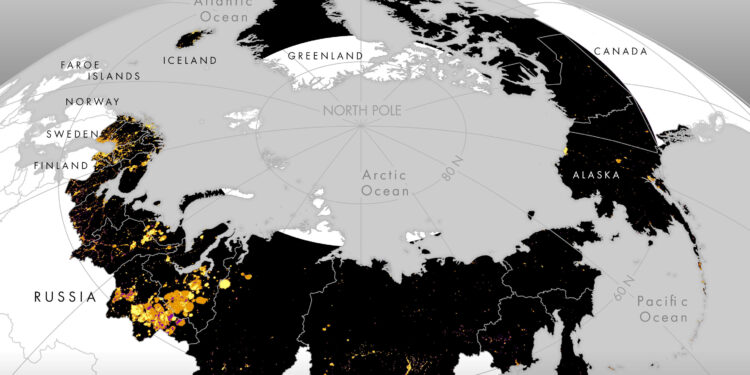Pan-Arctic map of light-emitting human activity showing unlit versus lit areas with significantly increasing or decreasing light-emitting human activity from 1992 to 2013. Credit: Cengiz Akandil, University of Zurich; Natural earth
More than 800,000 km2 of the Arctic were affected by human activity in 2013, according to an analysis of satellite data on artificial light at night. On average, 85% of light polluted areas are due to industrial activities rather than urban development. According to the international team led by UZH researchers, the results are crucial for sustainable development and nature conservation in this highly vulnerable region.
The Arctic is threatened by strong climate change: the average temperature has increased by around 3°C since 1979, almost four times faster than the global average. The region around the North Pole is home to some of the most fragile ecosystems in the world and has experienced low levels of anthropogenic disturbance for decades.
Warming has increased the accessibility of land in the Arctic, encouraging industrial and urban development. Understanding where and what types of human activities take place is essential to ensure the sustainable development of the region, both for people and the environment. Until now, a comprehensive assessment of this part of the world has been lacking.
More than 5% of the Arctic shows signs of human activity
An international research team led by Gabriela Schaepman-Strub from the Department of Evolutionary Biology and Environmental Studies at the University of Zurich (UZH) has now shed light on this question. In collaboration with American colleagues from NASA and the University of Wisconsin-Madison, UZH researchers used artificial nighttime light data observed from satellites to quantify hotspots and changes in activity in the Arctic from 1992 to 2013.
The study is published in the journal Proceedings of the National Academy of Sciences.
“More than 800,000 km2 were affected by light pollution, corresponding to 5.1% of the 16.4 million km2 analyzed, with an annual increase of 4.8%,” explains Schaepman-Strub. Using the new standardized approach, researchers were able to spatially assess human industrial activity in the Arctic, independent of economic data.
The European Arctic and the oil and gas extraction regions of Alaska, the United States and Russia were hotspots for human activity, with up to a third of the land surface illuminated. Compared to these regions, the Canadian Arctic was largely dark at night.
“We found that on average, only 15% of the illuminated surface of the Arctic contained human settlements, meaning that most of the artificial light is due to industrial activities rather than urban development. And this major source of light pollution is increasing both in terms of area and intensity each year,” explains first author Cengiz Akandil, a doctoral student in Schaepman-Strub’s team.
Effects on terrestrial ecosystems and regional sustainability
According to the researchers, these data provide an essential basis for future studies on the impact of industrial development on Arctic ecosystems.
“In the vulnerable permafrost landscape and tundra ecosystem, even simple repeated trampling by humans, and certainly the tracks left by tundra vehicles, can have long-term environmental effects that extend far beyond the illuminated area detected by satellites,” explains Akandil.
The negative impacts of industrial activities and light pollution are absolutely critical for Arctic biodiversity. For example, artificial light at night reduces the ability of Arctic reindeer to adapt their eyes to the extreme blue color of winter twilight, allowing them to find food and escape predators. It also delays leaf coloring and leaf bud breakage, which is essential for arctic species where the growing season is limited.
Additionally, human activities are driving the expansion of invasive species in the Arctic, and oil and gas extraction frequently leads to environmental pollution, as does the mining industry, which is also expanding.
Documenting industrial activity is crucial for sustainable development
The effects of rapid climate change in the Arctic require local communities to adapt quickly, and industrial development could further increase the need for adaptation and increase costs to society and the environment. The direct impacts of human activity on Arctic ecosystems could exceed or at least exacerbate the effects of climate change in the decades to come, researchers say. If the growth rate of industrial development between 1940 and 1990 is maintained, 50-80% of the Arctic could reach critical levels of anthropogenic disturbance by 2050.
“Our analyzes of spatial variability and industrial development hotspots are critical to supporting monitoring and planning for industrial development in the Arctic. This new information can help indigenous peoples, governments and stakeholders align their decision-making with the Sustainable Development Goals in the Arctic. Arctic,” concludes Schaepman-Strub.
More information:
Akandil, Cengiz et al, Artificial light at night reveals hotspots and rapid development of industrial activity in the Arctic, Proceedings of the National Academy of Sciences (2024). DOI: 10.1073/pnas.2322269121
Provided by the University of Zurich
Quote: Satellite data on artificial light at night indicates rapid increase in industrial activities in the Arctic (October 21, 2024) retrieved October 21, 2024 from
This document is subject to copyright. Except for fair use for private study or research purposes, no part may be reproduced without written permission. The content is provided for informational purposes only.



